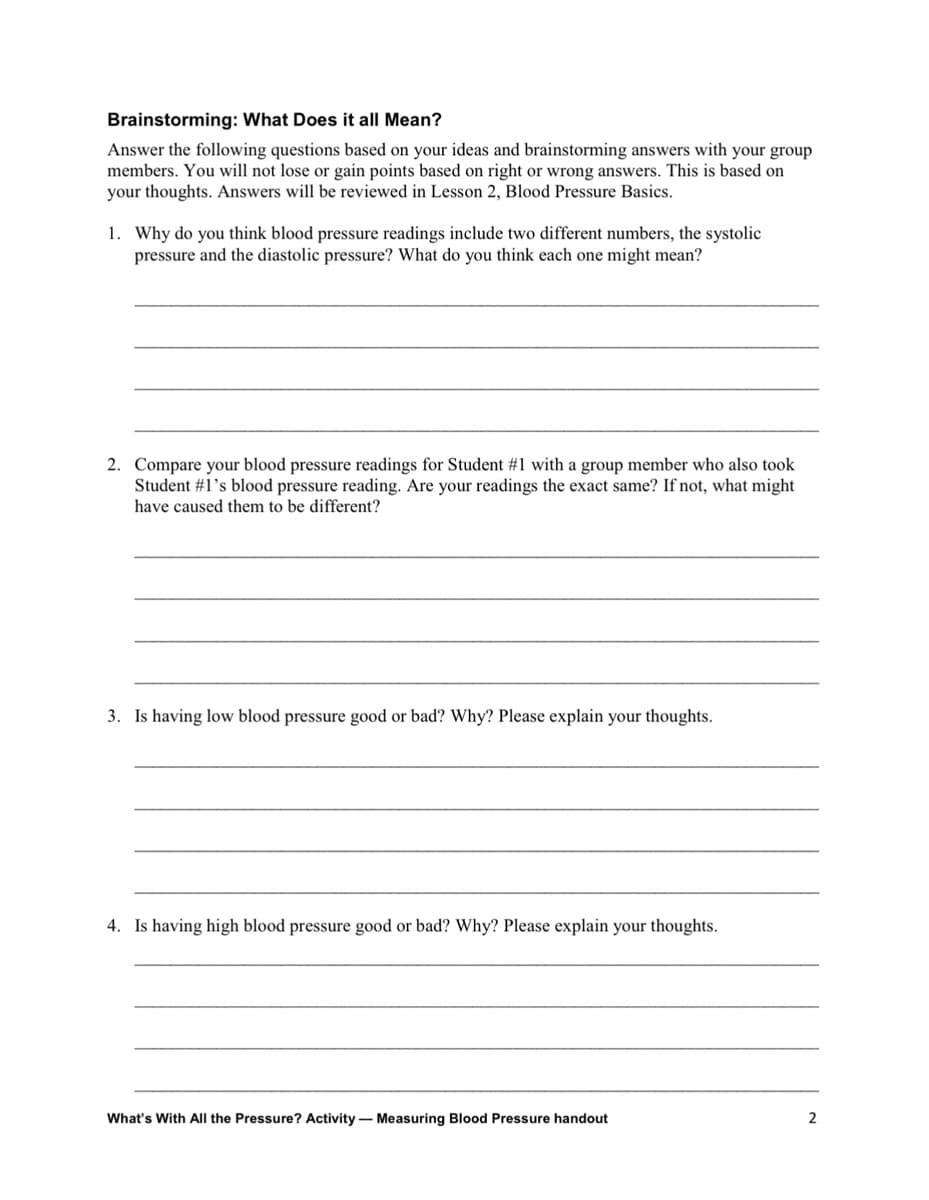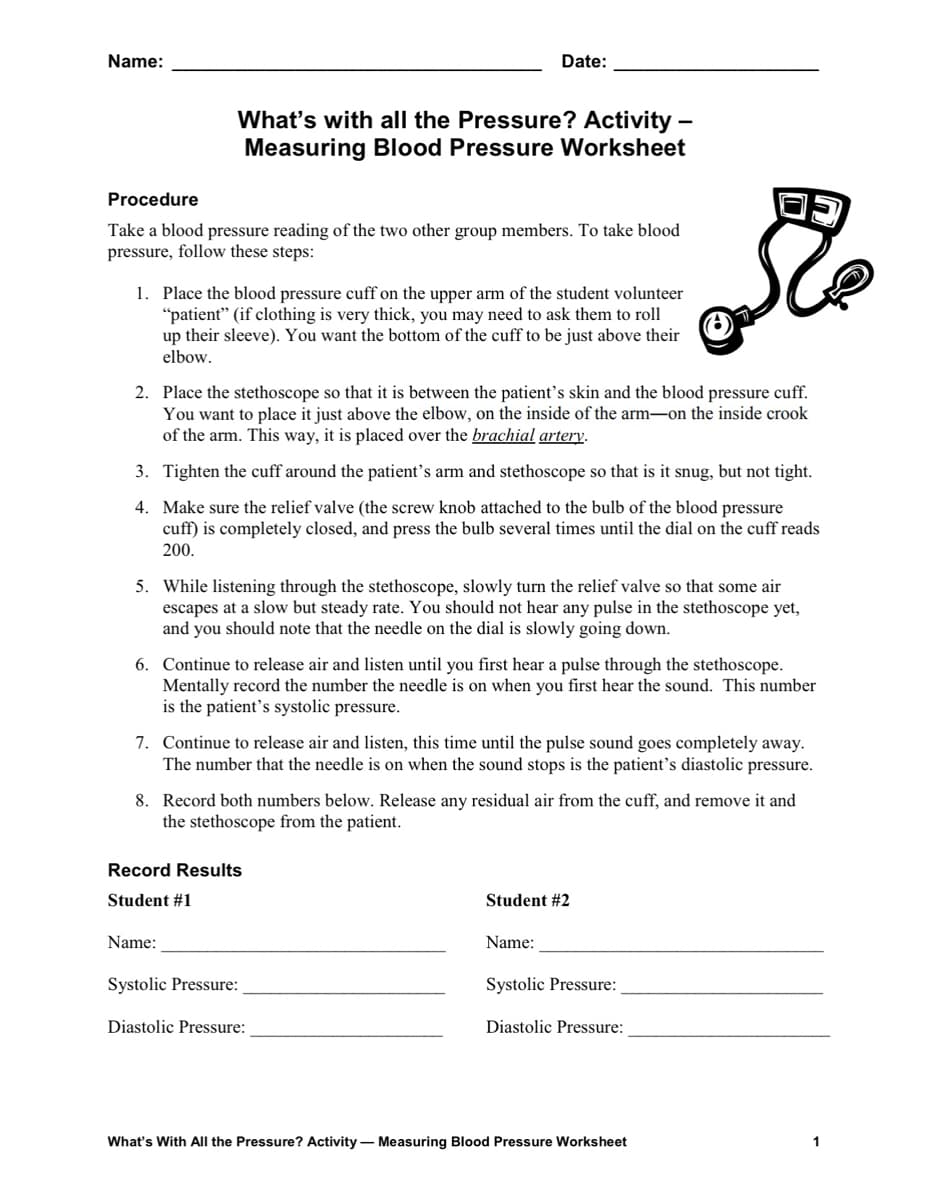Brainstorming: What Does it all Mean? Answer the following questions based on your ideas and brainstorming answers with your group members. You will not lose or gain points based on right or wrong answers. This is based on your thoughts. Answers will be reviewed in Lesson 2, Blood Pressure Basics. 1. Why do you think blood pressure readings include two different numbers, the systolic pressure and the diastolic pressure? What do you think each one might mean? 2. Compare your blood pressure readings for Student #1 with a group member who also took Student #1's blood pressure reading. Are your readings the exact same? If not, what might have caused them to be different? 3. Is having low blood pressure good or bad? Why? Please explain your thoughts. 4. Is having high blood pressure good or bad? Why? Please explain your thoughts. What's With All the Pressure? Activity - Measuring Blood Pressure handout 2 Name: Date: What's with all the Pressure? Activity - Measuring Blood Pressure Worksheet Procedure Take a blood pressure reading of the two other group members. To take blood pressure, follow these steps: 1. Place the blood pressure cuff on the upper arm of the student volunteer "patient" (if clothing is very thick, you may need to ask them to roll up their sleeve). You want the bottom of the cuff to be just above their elbow. 2. Place the stethoscope so that it is between the patient's skin and the blood pressure cuff. You want to place it just above the elbow, on the inside of the arm-on the inside crook of the arm. This way, it is placed over the brachial artery. 3. Tighten the cuff around the patient's arm and stethoscope so that is it snug, but not tight. 4. Make sure the relief valve (the screw knob attached to the bulb of the blood pressure cuff) is completely closed, and press the bulb several times until the dial on the cuff reads 200. 5. While listening through the stethoscope, slowly turn the relief valve so that some air escapes at a slow but steady rate. You should not hear any pulse in the stethoscope yet, and you should note that the needle on the dial is slowly going down. 6. Continue to release air and listen until you first hear a pulse through the stethoscope. Mentally record the number the needle is on when you first hear the sound. This number is the patient's systolic pressure. 7. Continue to release air and listen, this time until the pulse sound goes completely away. The number that the needle is on when the sound stops is the patient's diastolic pressure. 8. Record both numbers below. Release any residual air from the cuff, and remove it and the stethoscope from the patient. Record Results Student #1 Name: Systolic Pressure: Diastolic Pressure: Student #2 Name: Systolic Pressure: Diastolic Pressure: What's With All the Pressure? Activity - Measuring Blood Pressure Worksheet
Brainstorming: What Does it all Mean? Answer the following questions based on your ideas and brainstorming answers with your group members. You will not lose or gain points based on right or wrong answers. This is based on your thoughts. Answers will be reviewed in Lesson 2, Blood Pressure Basics. 1. Why do you think blood pressure readings include two different numbers, the systolic pressure and the diastolic pressure? What do you think each one might mean? 2. Compare your blood pressure readings for Student #1 with a group member who also took Student #1's blood pressure reading. Are your readings the exact same? If not, what might have caused them to be different? 3. Is having low blood pressure good or bad? Why? Please explain your thoughts. 4. Is having high blood pressure good or bad? Why? Please explain your thoughts. What's With All the Pressure? Activity - Measuring Blood Pressure handout 2 Name: Date: What's with all the Pressure? Activity - Measuring Blood Pressure Worksheet Procedure Take a blood pressure reading of the two other group members. To take blood pressure, follow these steps: 1. Place the blood pressure cuff on the upper arm of the student volunteer "patient" (if clothing is very thick, you may need to ask them to roll up their sleeve). You want the bottom of the cuff to be just above their elbow. 2. Place the stethoscope so that it is between the patient's skin and the blood pressure cuff. You want to place it just above the elbow, on the inside of the arm-on the inside crook of the arm. This way, it is placed over the brachial artery. 3. Tighten the cuff around the patient's arm and stethoscope so that is it snug, but not tight. 4. Make sure the relief valve (the screw knob attached to the bulb of the blood pressure cuff) is completely closed, and press the bulb several times until the dial on the cuff reads 200. 5. While listening through the stethoscope, slowly turn the relief valve so that some air escapes at a slow but steady rate. You should not hear any pulse in the stethoscope yet, and you should note that the needle on the dial is slowly going down. 6. Continue to release air and listen until you first hear a pulse through the stethoscope. Mentally record the number the needle is on when you first hear the sound. This number is the patient's systolic pressure. 7. Continue to release air and listen, this time until the pulse sound goes completely away. The number that the needle is on when the sound stops is the patient's diastolic pressure. 8. Record both numbers below. Release any residual air from the cuff, and remove it and the stethoscope from the patient. Record Results Student #1 Name: Systolic Pressure: Diastolic Pressure: Student #2 Name: Systolic Pressure: Diastolic Pressure: What's With All the Pressure? Activity - Measuring Blood Pressure Worksheet
Biomedical Instrumentation Systems
1st Edition
ISBN:9781133478294
Author:Chatterjee
Publisher:Chatterjee
Chapter9: Instrumentation In Blood Circulation
Section: Chapter Questions
Problem 4P
Related questions
Question
The questions are on the image

Transcribed Image Text:Brainstorming: What Does it all Mean?
Answer the following questions based on your ideas and brainstorming answers with your group
members. You will not lose or gain points based on right or wrong answers. This is based on
your thoughts. Answers will be reviewed in Lesson 2, Blood Pressure Basics.
1. Why do you think blood pressure readings include two different numbers, the systolic
pressure and the diastolic pressure? What do you think each one might mean?
2. Compare your blood pressure readings for Student #1 with a group member who also took
Student #1's blood pressure reading. Are your readings the exact same? If not, what might
have caused them to be different?
3. Is having low blood pressure good or bad? Why? Please explain your thoughts.
4. Is having high blood pressure good or bad? Why? Please explain your thoughts.
What's With All the Pressure? Activity - Measuring Blood Pressure handout
2

Transcribed Image Text:Name:
Date:
What's with all the Pressure? Activity -
Measuring Blood Pressure Worksheet
Procedure
Take a blood pressure reading of the two other group members. To take blood
pressure, follow these steps:
1. Place the blood pressure cuff on the upper arm of the student volunteer
"patient" (if clothing is very thick, you may need to ask them to roll
up their sleeve). You want the bottom of the cuff to be just above their
elbow.
2. Place the stethoscope so that it is between the patient's skin and the blood pressure cuff.
You want to place it just above the elbow, on the inside of the arm-on the inside crook
of the arm. This way, it is placed over the brachial artery.
3. Tighten the cuff around the patient's arm and stethoscope so that is it snug, but not tight.
4. Make sure the relief valve (the screw knob attached to the bulb of the blood pressure
cuff) is completely closed, and press the bulb several times until the dial on the cuff reads
200.
5. While listening through the stethoscope, slowly turn the relief valve so that some air
escapes at a slow but steady rate. You should not hear any pulse in the stethoscope yet,
and you should note that the needle on the dial is slowly going down.
6. Continue to release air and listen until you first hear a pulse through the stethoscope.
Mentally record the number the needle is on when you first hear the sound. This number
is the patient's systolic pressure.
7. Continue to release air and listen, this time until the pulse sound goes completely away.
The number that the needle is on when the sound stops is the patient's diastolic pressure.
8. Record both numbers below. Release any residual air from the cuff, and remove it and
the stethoscope from the patient.
Record Results
Student #1
Name:
Systolic Pressure:
Diastolic Pressure:
Student #2
Name:
Systolic Pressure:
Diastolic Pressure:
What's With All the Pressure? Activity - Measuring Blood Pressure Worksheet
Expert Solution
This question has been solved!
Explore an expertly crafted, step-by-step solution for a thorough understanding of key concepts.
Step by step
Solved in 2 steps

Recommended textbooks for you


Human Physiology: From Cells to Systems (MindTap …
Biology
ISBN:
9781285866932
Author:
Lauralee Sherwood
Publisher:
Cengage Learning

Biology 2e
Biology
ISBN:
9781947172517
Author:
Matthew Douglas, Jung Choi, Mary Ann Clark
Publisher:
OpenStax


Human Physiology: From Cells to Systems (MindTap …
Biology
ISBN:
9781285866932
Author:
Lauralee Sherwood
Publisher:
Cengage Learning

Biology 2e
Biology
ISBN:
9781947172517
Author:
Matthew Douglas, Jung Choi, Mary Ann Clark
Publisher:
OpenStax